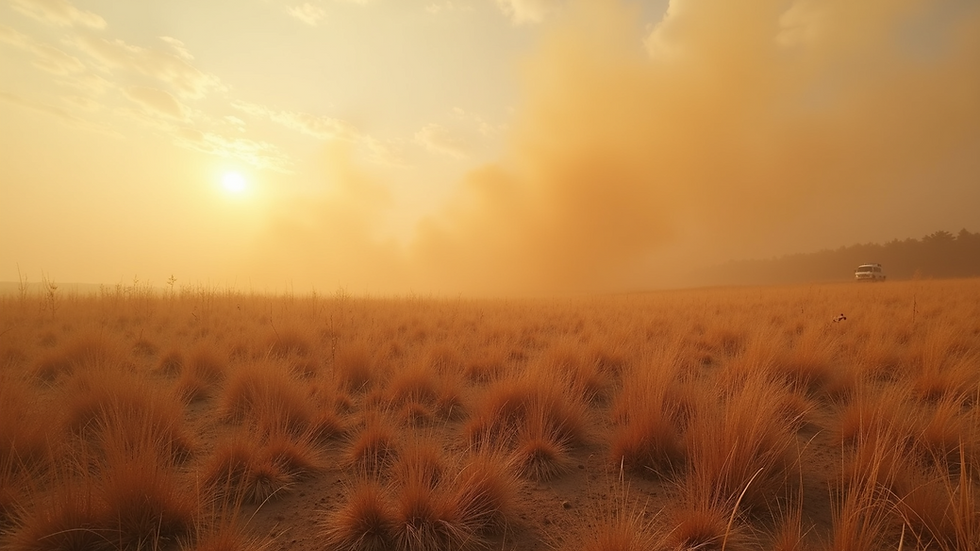the Implications of the Fire Weather Watch in Effect Until Tonight
- edu.plus.weatherray Rome
- Aug 3
- 4 min read
Wildfires can devastate landscapes, disrupt communities, and threaten ecosystems. When specific weather conditions align, we face a serious risk. Currently, a fire weather watch is in effect until 12 PM tonight, signaling that we need to be alert and proactive.
This post explores what a fire weather watch means, the underlying factors contributing to it, and how everyone can stay safe and prepared during these critical times.
What Is a Fire Weather Watch?
A fire weather watch serves as an important alert indicating that atmospheric conditions are ripe for rapid wildfire spread. These conditions often include:
Dry Weather: Insufficient rainfall leaves vegetation vulnerable to ignition.
High Temperatures: Temperatures above 90°F can increase the likelihood of fire.
Low Humidity: When humidity drops below 25%, the chances of fires igniting rise significantly.
Strong Winds: Wind speeds exceeding 15 mph can carry flames and embers across vast areas.
Unlike warnings, which suggest that fires are imminent or already occurring, a watch gives residents time to prepare and prevent potential fires.
Weather Conditions Contributing to the Watch
Several specific weather factors contribute to the issuance of a fire weather watch:
Temperature: For instance, if temperatures are consistently at or above 95°F in a region with sparse vegetation, the risk for fire ignition increases dramatically.
Humidity: Low humidity levels, especially below 20%, remove moisture from plants, making them dry and highly flammable.
Wind: Wind gusts reaching 20 to 30 mph can lead to fires spreading quickly, sometimes even creating spot fires at great distances from the original source.
Understanding these conditions can help individuals better assess the risks in their own communities during this heightened alert.
Risks and Implications
The implications of a fire weather watch extend beyond just the threat of fire. Communities should consider several key factors:
Increased Fire Risk: In regions affected by a fire weather watch, the risk of wildfires can increase by over 50%, posing threats to lives, homes, and natural habitats.
Air Quality: According to the EPA, smoke from wildfires can degrade air quality considerably, affecting those with respiratory conditions. For example, particulate matter (PM2.5) can spike sharply, posing health risks even to healthy individuals.
Emergency Response: During heightened risk periods, firefighting resources may be limited. This can lead to delays in response times, especially if multiple areas are affected simultaneously.
Awareness of these implications can empower communities to take appropriate precautionary measures.
Preparing for a Fire Weather Watch
To effectively prepare during a fire weather watch, take the following practical steps:
Create an Emergency Kit: Your kit should include essentials like at least one gallon of water per person per day for three days, non-perishable food, medications, and a flashlight.
Develop a Fire Evacuation Plan: Outline escape routes and identify safe locations. Make sure family members are familiar with these plans and check in regularly during a watch.
Remove Fire Hazards: Clear your yard of dry leaves, wood piles, and other potential kindling. Creating a defensible space around your home can decrease the risk of fire damage by up to 67%.
Taking these steps can significantly lower risks during a fire weather watch and protect your family and property.
Community Response and Resources
In addition to individual preparations, collective community responses are vital in managing fire risks. Key resources include:
Local Fire Departments: Many fire departments provide updates on the local fire danger level and offer safety tips tailored to your area.
Weather Services: Utilize local meteorological services for ongoing updates about the fire weather watch, which can include forecasts and any warnings.
Community Engagement: Collaborate with neighbors through community boards or social media groups. Sharing information and resources can enhance overall community preparedness.
Working together ensures that everyone is better informed and ready for action if necessary.
Staying Informed Is Key
During a fire weather watch, staying informed is critical. Here's how:
Regularly check local news for updates on fire risks and safety recommendations.
Follow local authorities on their social media platforms for real-time information.
Sign up for emergency alert notifications from your city or county to stay updated.
By remaining aware of the situation, you can make timely and informed decisions, especially if evacuation becomes necessary.
Final Thoughts
As local authorities monitor conditions that lead to fire weather watches, it is crucial for individuals to stay vigilant. Understanding the risks associated with elevated fire dangers helps empower us to take meaningful actions that can protect lives and properties.
By being informed, prepared, and proactive, each person plays a role in reducing the possible impacts of wildfires. In these uncertain times, safety should always be our top priority.



By embracing a collective approach to safety, we can navigate the challenges posed during these vulnerable periods. Stay informed and prepared, as the impacts of wildfires can be mitigated through diligence and action.



Comments